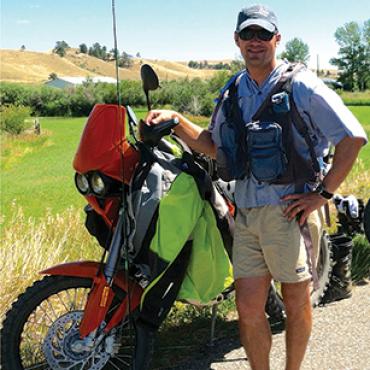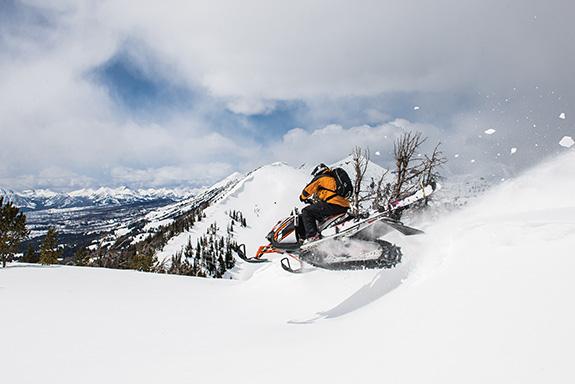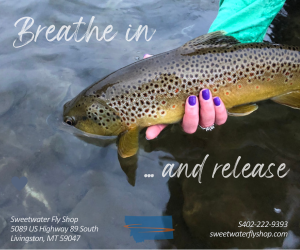Certainly Unstable
Finding clarity in the oft-obstructed views of the backcountry.
“I’m in,” Evan said, finishing off his espresso in what he’d dubbed the “Poet’s Corner” of what was at the time the only real coffee shop in Belgrade. It was November 2012, and we were teachers taking an extended lunch hour before jumping into an afternoon of what the state Office of Public Instruction calls “P.I.R.,” a teacher’s brand of professional development.
Evan was responding to my proposal of an overnight backcountry ski trip south of Big Sky. The plan was to ride 14 miles into the mountains on snowmobiles to the Yellow Mule Cabin, which lies somewhat hidden just off Buck Ridge in an area known mostly to sledheads, a less-than-friendly name for snowmachine enthusiasts.
Evan and I would use the snowmobile access to our advantage. Since I owned a sled and had a friend who might be willing to part with his for the weekend, we’d load up our sled trailers with ski gear and everything required for a couple of nights at the cabin, then ride off to more remote locations from which we could skin our way to skiable lines. The odyssey would last for two nights and three days, and hopefully the weather and snowpack would cooperate. Ideally, we were both hoping for some transcendent turns through deep snow untouched by both skiers and grooming machines. At least I was. I think Evan may have been looking for something more radical: cliffs, steep couloirs, and lines that could only be identified through the lens of risk and challenge.
Either version of bliss seemed far from our present reality, however, as we sat helpless on the brink of a professional-development lecture given by some public-education bureaucrat. Also gnawing at our brains was the bare-assed fact that neither of us had any multi-day winter backcountry experience.
Winter in the Northern Rockies kills quickly; it’s an unforgiving season. This bit of situational awareness caused an underlying spring of anxiety that, at best, provided motivation and, at worst, caused us to look at each other cautiously and skeptically, wondering if we were foolishly and absurdly planning our own particular tragedy.
Pulling up in front of Evan’s house on the morning of our trip, I found his entire family, excepting the infant, standing there on the porch for the send-off. His wife and the three children looked on in their Saturday-morning slumber attire. Carter, the third member of our party, decidedly without children, opened the door of my pickup to greet the crowd and help load gear. Sirius XM’s “Jam On” was playing the usual Widespread Panic and Evan raced about, also looking eager and anxious.
The raison d’etre of our trip was backcountry skiing. In the backcountry there are no chairlifts, no avalanche control, and no ski patrol. You’re on your own and becoming the victim of an avalanche is a very real possibility. This was not lost on Evan’s wife, nor mine, nor Carter’s. Just three weeks before our trip, a high-school English teacher had died in an avalanche while backcountry skiing near Whitefish, an event which was not overlooked by anyone in the party. Our situation had become awkward and our attempts at reassurance inept. But in a flush of goodbyes, Evan was in the back seat of my pickup and the three of us were heading out to a trailhead 50 miles to the south in Gallatin Canyon.
At the trailhead, the last strap cinched, Evan and I attempted to go through a checklist but failed halfway through because there was too much gear to remember. The truck keys were safe, all of the electronics were functioning, the cabin’s lock combination was placed in three different locations, and our avalanche beacons were on. There was nothing left but to straddle the sleds, squeeze the thumb-throttle, and go.
Making our way across the highway and up that first mile of trail, I remembered how a colleague of ours we had pitched the trip to had described us as “certifiable.” He almost seemed angry and resentful about what he perceived to be an ill-conceived and irresponsibly approached experience and at our audacity in attempting it. The palpable anxiety he exuded presumably arose from the thought that he might go along with us. The next day, Evan and I concluded we were fortunate that our colleague’s emotional dam burst while discussing the trip in a coffee house rather than beside a snowpit in McAtee Basin. It’s not that his perceptions were altogether incorrect. What Evan and I had in mind could understandably be viewed as a kind of “wing-and-a-prayer” approach. But it was the first iteration and required some faith.
But that’s the problem with what is known to avalanche experts as “the human factor.” You can assess weather, terrain, and snowpack. You can even come to understand these phenomena with a reasonable degree of certitude. But what will be the gut-reaction of a human being to whatever scenario the mountains create for him? And what about the vicissitudes of the mind which have the potential for a level of instability equal to a dangerous snowpack? The problem is that within the former you can dig a pit, make incisions with cord and saw, and tap your way to a prediction; with the latter, you can only use your own questionable judgement to determine whether the slope is safe to ski or not.
To our amazement, the two sleds hauled our asses and pulled the gear without much of a problem. We moved along at about 12 miles per hour, waypoint to waypoint. By the time our sleds surmounted Buck Ridge, we were euphoric. The sky was blue, the snow was white, and we were riding into a winter playground of epic proportions. Skis, snowmobiles, cabins in winter, and seemingly endless quantities of snowy terrain—this was a first.
On the GPS, the Yellow Mule Cabin was only four miles away. The snow was providing good traction for the sleds and the weather was stable. With no rearview mirrors for proof, I trusted that Carter would be in equally good form. About halfway through a ridgetop glade, however, Evan shook my shoulder. “Uh-oh!” he let out, and then a nervous chuckle. “Carter’s trailer disconnected.”
Slowly squeezing the brake and bringing my snowy version of a train to a stop, I looked back to see Carter’s gear-laden trailer sliding along, now pulled by gravity, into an abyss of timber off the side of the ridge while Carter stood on his snowmobile helplessly watching.
That Carter’s trailer disconnected was not really a shocker. He had been in one of his moods when we hit the hardware store to put together a jerry-rigged hitch. Being that he’s an artisan carpenter, we trusted in his engineering acumen to come up with something sturdy. But when Carter is feeling depressed, like most of us, his actions don’t always add up. The surprise was that his half-hearted creation of a hitch had made it that far.
Of course, all of this is what makes a trip an adventure. The uncertainty of nature, your own tenuous mental and emotional stability and that of your friends, the tendency of gear to fail, and, more recently, the ever-increasing fragility of our middle-aged bodies. You do everything within your limited capacity to ensure a fail-safe journey but prepare yourself for the worst.
Soon, Carter was pulling NRS straps out of our supply bag and building a hitch out of 1,000-pound nylon cord. His melancholy had been replaced with alacrity and verve. Apparently the necessity for invention brought about by the backcountry is refreshingly therapeutic. It’s a place that demands resilience and creativity along with intuition and instinct. The final cam buckle secured, Carter throttled his sled and we hung behind, waiting to see if he’d make it out of the trees and if his newly rigged system would hold. It did.
Four miles later, we arrived at a sign proclaiming the Yellow Mule Cabin to be just below us. Supposedly, it was just off the main ridge and hidden within a grove of mature pines in the big meadow below. With hundreds of pounds of gear on the trailers behind us, I took some small amount of comfort in the thought that our load would be lightened by our use of fuel, water, and food over the next couple of days. But once the sleds were pointed downhill and we were pushing through nearly a foot of powder toward the meadow floor, the thought of not being able to climb out of this basin was impossible to ignore.
Standing up on the running boards with cold-smoke powder coming up and over the front of the sled, my anxiety about getting back up had been replaced by the satisfaction of realizing I’d committed to something worthwhile. We’d “dropped in” and I was enjoying the physical and emotional scenery. There was only a fading snowmobile track heading from the meadow into the trees to show us the way to the cabin, and as I pulled up in front of the door, Evan jumped off the back of our sled before I could shut down the engine and set the parking brake. As if attempting a rescue in the immediate aftermath of a slide, he pulled out his avalanche shovel and started feverishly digging out a path to the cabin door.
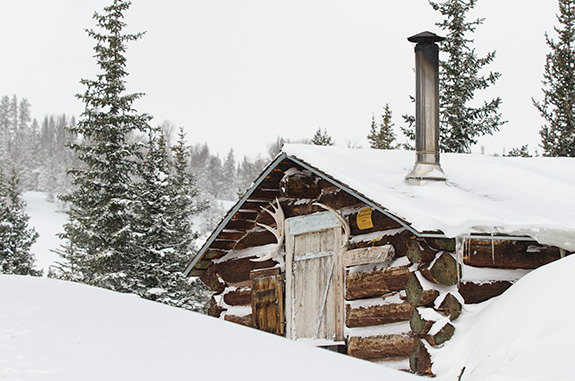
By the time I had the first load of gear in hand, Evan had finished clearing the entry and was on to clearing out the drift in front of the cabin’s main window. Carter, meanwhile, sat on the back of his sled meditatively smoking a cigarette and staring at the mountains to the east that we might ski the next day, his experienced backcountry eyes searching out safe lines. After unpacking the sleds, I built a fire in the cabin’s woodstove. Satisfied to have our first fire started, I heard something on the roof and stepped out to find Evan, skis on, preparing to jump off the edge of the cabin and into the chest-deep snowdrift along its side.
The cabin sat at the bottom of the ultimate toboggan hill. The slope was just over 25 degrees and in no danger of avalanching, perfect for our first turns.
“Here’s the ski rope,” Evan said, shaking the rope in the air at us with giddy gestures.
“Boot up and click in. You’re up first,” I said, giving him a fist pump.
“I’ll watch,” Carter offered. “If you guys wreck the sled and yourselves, there will be someone around to pick up the pieces.”
“Thanks for the optimism, brother. I’d like to think we’ll save some snow for you, but…”
With that, I pulled the 800cc Rotax motor to life. Now free from its heavy burden, the machine lurched forward as I hit the throttle and pointed it uphill. The sled pulled Evan along just as a ski-boat does a water-skier; I actually had to throttle back as I crested the hill, where I attempted to keep Evan going behind me at a speedy clip. Navigating the sled in a large semicircle on top of the ridge, I then aimed for the top of the hill. Evan broke outside the “wake” of the sled and began pulling toward the outer edge, gaining speed as he approached the crest of the slope. Releasing the rope, he let out a “barbaric yawp” as only an English teacher and Walt Whitman fan could pull off, and began making turns through the powder, seeking out boulders and fallen logs to launch off. I rode along parallel to his descent, and by the time he had reached the bottom of the slope and caught his breath, I was dragging the tow rope beside him for another round.
This went on for hours, each of us taking turns as rider and skier until it was too dark to see. We would have donned headlamps and continued into the night but our legs became awash with lactic acid and began to fail. The cabin called, and it was warmed up now from the fire I’d built earlier. Carter had kept it stoked and the cabin glowed invitingly in the fading twilight. We had made it there. We were still alive, and two of us had already made turns into the dark. It was then that I started to confide to myself that I was having fun, a lot of fun, maybe more fun than I’d ever had in my life.
The next morning found us up early and heading out on the sleds toward our first big lines. We stopped on the leeward, east-facing side of the ridge and began putting on our skins. Before I could even unpack mine, Evan was geared-up and skinning diagonally across the slope. Carter hadn’t bothered unpacking his skins and was walking leisurely over to the west facing side of the mountain to dig a snowpit in the sun. I sat back down on my sled befuddled, thinking that whatever we were doing, we should be doing it together and there should be, at the very least, a plan.
My skins on, I worked my way over to Carter to lend a hand with the snowpit. He had about half of it dug out and began finger-testing the varying layers within the snowpack, looking for instabilities. My shovel in hand, I finished digging out the rest of the pit, attempting to form clean rectangular lines out of the accumulated snow that would allow for a true test of what we’d be skiing on. Of course, Carter had dug his pit on top of the sunny, west-facing slope and we’d be skiing the shaded northeast aspect, so the whole thing was somewhat pointless. Maybe this is why Evan had not even bothered heading that way in the first place. Now he was digging his own snowpit just below the top of the east-facing slope to the side of the steeper, avalanche-prone section of the descent.
Tap, tap, tap. Carter’s hand barely influenced the weight of the shovel resting on top of our isolated column as he moved it from his wrist only. Then he gently slapped the surface of the shovel with a movement initiated at his elbow. Finally, he made full swings at the shovel from the starting point of his shoulder from which he hit the metal surface hard enough to make his hand hurt. On the third stroke, the isolated column collapsed about two inches, breaking on a weak layer of facets about two feet below the surface of the snowpack. The weak layer propagated across the column and everything above it slid off into the bottom of the pit. Carter and I looked at it with ambivalence. The snowpack wasn’t altogether unstable, but it wasn’t exactly safe, either.
The results we got out of Evan’s pit were more promising. It can be that way. Skin 100 yards to a different spot and the mood of the snow changes. Expanding Evan’s snowpit to the size of a chest freezer, citing avalanche-training classes taken during an exchange year in Utah, Carter began explaining to us that he was setting up a “Rutschblock Test.” Evan seemed to know what he was talking about and immediately leapt up above the isolated block of snow. The idea is to have the weight of an actual skier to test the snowpack. It started with Evan gently stepping on to the block, allowing his full body weight to influence the snowpack. Then, he sprung up and down to put some more pressure on the snow. Still no movement, no adjustment to the layers below. Almost manically, Evan jumped up in the air and pounced upon the snow with all of his energy, exerting a force strong enough to find the weakest layers hidden at the bottom of the snowpack. They had formed in late November and early December with the first storms of the season and subsequent frigid temperatures. They were not likely to be affected by anything that high above on the snow’s surface, but the right combination could trigger them. The slide that would ensue would be catastrophic in scope, a slab breaking at the ground with size and strength capable of clearing a forest. We all looked at the heap of fractured snow like Hamlet gazing into Yorick’s skull. To ski or not to ski? No matter how many pits dug or tests conducted, that is the inevitable question the skier is always faced with.
We chose to ski. The risk was tolerable; the reward sublime. Descending through the glades with a surface beneath me that had not experienced any human contact the entire season produced a sensation that I am still infatuated with today. There is nothing harsh, firm, or edgy. It’s as if you can feel something bottomless underneath you. The sensation leads to a transcendence that leads to a euphoria which makes it hard to readjust one’s self to the danger that is omnipresent. I had been into the backcountry several times looking for those turns. I knew when I skied up beside Carter and Evan that I had found them.
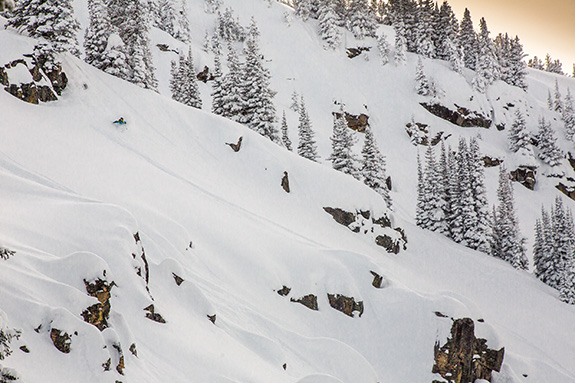
We skied another line that day, much bigger, more ambitious, and riskier. But those turns weren’t there. By the time we skinned to the summit and started our descent, the snowpack had changed, becoming much heavier and damp with the subtly-rising afternoon temperature. The descent was still memorable in that it was the longest backcountry run any of us had ever experienced, but there was something anticlimactic about it, and the difference was in the snow.
Having made it back to our sleds, we blissfully clicked out of our skis and began adjusting ourselves for the ride back to the cabin. Carter was smiling. Evan was hooting and howling like a teenager who had just scored the winning touchdown, and I was feeling—for the first time—the glow of a good day spent on skis in the backcountry. Together we assembled into our bizarre train, with me at the handlebars, Carter riding two-up, and Evan standing musher-style on the very back of the gear sled. The somewhat absurd image we created moving across the backcountry probably provided a unique sight to anyone else who happened to be on Buck Ridge at that moment. I doubt it’s been duplicated. The entire act surely deviated in all the right ways from piling onto a chairlift at a ski resort. Most of all, it was fun. Really fun. Dangerously fun. And we were heading to our cabin for a night filled with warmth from a fire, elk steaks on a skillet, wine by the bottle, with talk of what had been and what was to come, finally drifting off with images of the day playing across our mind in that surreal way made possible only by doing one thing that you love for all of your waking hours.

